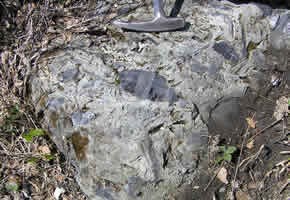BY WENDY BIRD
With help from two Thunder Bay high school science teachers who have spent the last 15 years studying ejected material from the Sudbury meteor impact, Minnesota geologist Mark Jirsa can say with confidence rock formations he discovered a couple of months ago in the northeastern part of the state are likely from the Sudbury area.
“I didn’t know right away what I had found. It was a lightbulb moment I had on the long drive back to Lutsen, Minnesota. At one point I pulled over, pulled out a map and said ‘my, gosh, this is at that right interval in that layer cake of geology.’”
Luckily for Jirsa, Thunder Bay scientists Bill Addison and Greg Brumpton were in Minnesota attending the annual meeting for the Institute on Lake Superior Geology.
“I was able to show the samples to Addison and Brumpton and they said, ‘you got it’!”
This kind of material has always puzzled geologists, said Jirsa. The complex products of impact range from angular fragments of pre-existing rocks and partially melted, recrystallized, or glassy fragments, to spherules that condense from vapour in the ejecta cloud (much like hail stones form in rain clouds).
“This material is not immediately recognizable,” Jirsa said. “It wasn’t until about two or three years ago when these high school science teachers discovered (it) and did a very thorough and careful job of age dating the rocks that overly and underly similar deposits in the Thunder Bay area.”
The pair published their findings in the March 2005 journal published by the Geological Society of America.
“It is to the credit of Addison’s and Brumpton’s careful scientific work that we know roughly what the age of this material is and we know specifically now. When the first age dates came out on the Sudbury intrusion (which is second largest impact structure on the planet), and when it was first accepted that the intrusion was the product of a tremendous impact event, these two guys thought there ought to be material from this literally spread around the globe.”
Although Jirsa first discovered the Sudbury “ejecta” in May, the story didn’t really catch the public’s attention until the Associated Press picked it up earlier this month.
“I don’t deserve the credit for finding this (rock formation) in the first place ... really Bill and Greg do,” Jirsa said. “This is a uniquely Canadian story I think. What I’ve done is just an extension of their work completely. This is the first recognition of the material ejected from the impact in Sudbury.”
Jirsa, who himself has visited Greater Sudbury to study area rock formations, admits a lot of work lies ahead of this discovery.
“We need to map out the area, compare it to other materials from Canada and from other parts of the world. What we’re all doing with this now is looking at this material that was ejected and seeing what it can tell us about the Sudbury impact.”
So what kinds of stories could the rock formations tell? Jirsa is keenly interested in finding out why the ejected material has landed more than 700-kilometres away.
“Material that travels at ballistic speeds should be no farther from the impact site than about five times the radius of the impact site. So we’re a little further than that here in Minnesota to be receiving ballistic ejecta from the Sudbury site,” he said.
“So what does that tell us about the impact ... is it bigger than we thought? We don’t know much about it ... this happened 1.85 billion years ago.
Jirsa speculates that if this material is farther than it ought to be, perhaps different atmospheric conditions played a role, or perhaps the crater is much larger than scientists currently believe.
“Geologists are historians ... they are trying to figure out a historical story based on these little shreds of evidence that are scattered around Minnesota, Ontario, Michigan and possibly Wisconsin,” Jirsa said.
“There’s still a lot of work to be done. The farther back you go, the harder it is to be accurate.”
Join Sudbury.com+
- Messages
- Post a Listing
- Your Listings
- Your Profile
- Your Subscriptions
- Your Likes
- Your Business
- Support Local News
- Payment History
Sudbury.com+ members
Already a +member?
Not a +member?
Sign up for a Sudbury.com+ account for instant access to upcoming contests, local offers, auctions and so much more.
